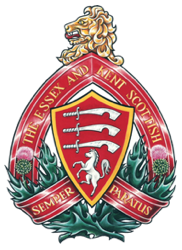Sergeant Chester Elmer Routley, DCM + Bar
In October 1914, Private C.E. Routley boarded a train in Petrolia with five other men from the 27th Regiment. Their destination was London, Ontario to enlist with the 18th Battalion, Canadian Expeditionary Force (CEF). Upon arriving in London, he was given basic training before leaving for England with the rest of the battalion in April 1915.
The 18th Battalion did more basic training in England after arrival. The 18th Battalion was then sent to the front line in France as part of the 2nd Canadian Division. Initially they were in the trenches on the Ypres salient for most of 1915 and 1916, but they transferred to the Somme River front in September 1916. The Battle of Fleurs-Courcelette was the first large scale engagement for the Canadians, which took place on 15 September. The battle used the creeping barrage and some of the first tanks to force the German infantry back into their trenches while the Canadian infantry trailed behind and secured positions. Though the Canadians captured the village of Courcelette, the casualty count at Courcelette was in the thousands. For the 18th Battalion, they lost ninety-one men in the first twelve hours and twelve more later due to injuries, which is nearly equal to their casualty total for the entire year before Courcelette. The entirety of the battle of the Somme resulted in approximately 24,000 casualties for Canadian Army.
In his memoir, Routley stated that “the whole heavens seemed to be on fire” during the battle. He was burned by a bullet that passed through his clothes, and by the time Routley checked the severity of his injury and left his make-shift cover, all his officers were gone. He liaised with officers from the 15th British Division to confirm the planned junction point before setting up Lewis guns and sending wounded men back to Battalion HQ. He and his men were ordered to advance. They reached Gun Pit Road, which was shadowed by a mound of earth a hundred meters from it. The higher position did not provide much protection, but its sightline was advantageous enough that Routley set up an observation post on the high ground himself. It was there that a large shell landed and wounded him, nearly burying him in the earth. He managed to get himself out and get medical care before evacuating. Routley’s effort to lead the men of “C” Company when all his company’s officers and senior N.C.O.s had been killed or injured showed incredible determination and bravery. Lance-Sergeant Routley received a Distinguished Conduct Medal (DCM) for his actions at Fleurs-Courcelette.
Routley again showed adaptability and quick-thinking at the Battle of Hill 70 in August 1917. Routley followed an enemy scout back to his trench line. He sent a flare up to call artillery to bombard the trench. In his memoir, he describes sending an S.O.S. radio signal to Allied artillery when his men were bogged down in the trench at Cité St. Elizabeth and acting as the platoon lookout. While he noticed that some artillery had provided supporting fire he had not think they were responding to his urgent call. It was only later when talking to the battalion Adjutant that he found out the artillery had responded to his call for support. It is this resourcefulness and bravery that led Routley to receive a bar for his DCM, a feat that only thirty-seven other Canadians ever accomplished.
Story by Nicole Pillon, Canada Summer Jobs 2022 participant
with The Essex and Kent Scottish Regiment Association
Source
- Duty Nobly Done: The Official History of The Essex and Kent Scottish Regiment by Sandy Antal and Kevin R. Shackelton, 2006, Chapters 5, 6
- “Neglected Victory: The Canadian Corps at Hill 70” by Matthew Walthert, published in Canadian Military History, 2010
- https://18thbattalioncef.blog/soldiers-listed-in-diary/routley-chester-elmer-service-no-53610/
